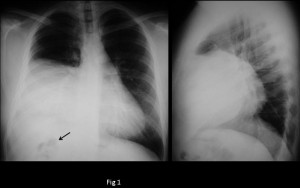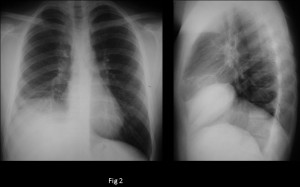
Dear friends,
As summer is here and the weather is hot, Muppet wants to show you an easy case:
Preoperative chest for urethral stenosis in a 26-year-old male.
Diagnosis:
1. Pleural mesothelioma
2. Lung tumor
3. Loculated fluid
4. None of the above

26-year-old man, PA chest

26-year-old man, Lateral chest
Click here for the answer to case #28
PA and lateral chest show an extrapulmonary opacity in the right lower lung field. There is a loop of bowel in the right upper quadrant (arrow), which may be due to Chialiditi’s syndrome or elevation of the colon, secondary to diaphragmatic hernia.

Muppet considered that hernia was a good possibility and investigated the clinical history: urethral stenosis was secondary to rupture of urethra and bladder neck as result of a motorcycle accident four years earlier. Chest films two years earlier (Fig 2) showed apparent elevation of the right hemidiaphragm, which was not reported.

These findings increased the suspicion of traumatic diaphragmatic hernia and led to a CT, which showed a rent in the diaphragm (Fig 3, arrows) with herniation of the liver. Hernia was surgically repaired; Muppet saved a life and was very proud of himself!

Teaching point: any lesion in close contact with the diaphragm may arise from below. In case of doubt, it is imperative to perform a CT.








This might be a tumor as seen in the lateral x ray
4 non above
Any suggestion?
ernia diaframatica di Morgagni-Larrey, a contenuto “solido” ( fegato-omento ecc.)
First of all, the information given (the patient’s age, gender and pathology) catches my attention. Is the urethal strictures caused by a trauma? An infection (STI)?
On the PA and lateral chest films I see a relatively well circumscribed anterior right based mass, that seems to have an extrapulmonary location/origin (the medial and superior margin in the PA and lateral films forms an obtuse angle with the chest wall). There is a blunted right lateral costo-frenic angle, signs of mass effect on the pulmonary parenchyma (like the displacement of the minor fissure in the lateral film), but there’s no mediastinal shift. I don’t see calcifications, rib destruction, pleural effusion (posterior costofrenic angle is not blunted) or other relevant changes in the chest film.
The findings remind me of a benign pleural lesion, like a fibroma (although I understand it is usually presents in older patients) or a lipoma, so my first choice is number 4. Nevertheless, as a second option I wouldn’t discard number 3.
Urethral stricture caused by trauma four years earlier
There may have been a congenital defect of the diaphragm and I think that with the trauma (you said: Urethral stricture caused by trauma four years earlier) there may have been increased intraabdominal pressure, and this made the migration of abdominal structures into the chest
Loculated fluid
Io penso ad una ernia diaframmatica, di Morgagni-Larrey, a contenuto “solido”( fegato-omento.etc.)
3-loculated fluid
Although its size make it difficult I woul locate the origin of the sharply marginated oppacity in the right cardiophrenic angle. It’s rounded, homogenous and seems to be extrapulmonary. My differential would include Morgagni’s hernia and huge pericardial cyst (option I prefer in this case).
The answer for me is 4. None of the above.
Pleural mesothelioma, lung tumor are not very usual in a 26 y.o. man.
Loculated fluid is rare in a patient with both posterior costophrenic angles clear.
It seems to me the pregnant sign can be seen on the lateral view. There is an opacity in the lower and back aspect of the “anterior clear space”
Could be it a Tymolipoma? Sometimes these tumours go down and puttheirselves in the costophrenic angle
Welcome back, Lola. You missed something.
May I know something about what I´ve missed? Could you give me a clue? After all is the Olimpycs´time when everybody feel generous.
Citius, altius, fortius, aereus.
I think the answer is 4. None of the above.
Pericardial cyst and Morgagni’s hernia are good options.
In the frontal view there is air in the right upper quadrant instead of the liver density, that’s why I think Morgagni hernia is the most likely diagnosis
How would you tie the hernia to the urethral stricture?
I made a mistake, answered elsewhere above
There may have been a congenital defect of the diaphragm and I think that with the trauma (you said: Urethral stricture caused by trauma four years earlier) there may have been increased intraabdominal pressure, and this made the migration of abdominal structures into the chest
Could it be a traumatic hernia?
It was said in case 26: If previous trauma is elicited, traumatic hernia should be ruled out.
But it was also mentioned that an elevated diaphragm usually has a concave, well-defined border (like this case)
, whereas hernias have an irregular and flatter contour.
I keep thinking of a hernia despite the previously mentioned
. I thought of Morgagni hernia because it is located in the anterior side of the right hemidiaphragm
but I can not rule out a traumatic diaphragmatic hernia
The right hemi-diaphragm is raised with air present in the subdiaphragmatic region. Is the patient septic? I would include subdiaphragmatic abscess in the differential diagnosis if so.
Patient was asymptomatic. This is a preo-op film
Hmm is it gross right-sided hydronephrosis secondary to urinary obstruction?
NO. Sorry
Answering Mm here, because there is no room left!
In my opinion, the role of the CXR is to suspect an specific abnormality. Once you do that, you should use the most appropiate diagnostic method to confirm your suspicion.
Sorry if my wording in case 26 misled you. What I said works most of the time; but nor all times (nothing does). As somebody said: “don’t believe anything you hear and only half of what you see”.
But one thing stands: a density in contact with the diaphragm may come from below.
But couldn’t it be a chilaiditi sign? I mean, I considered diaphragmatic hernia as a possibility, but as far as I concern it’s not common that it doesn’t contain intestine and that it’s assymptomatic in this location and with this size. With this and considering the classical three differential diagnostic of opacities in this location (Morgagni, lipoma and pericardial cyst) I chose one (pericardial cyst because of the homogeneity, the rounded shape and the abscence of symptoms). Anyway, the hernia is for sure a possibility and maybe the best with the trauma history. A CT is unavoidable from my point of view.
It could be a Chilaiditi’s; but, as you say, CT is unavoidable. Better safe than sorry. Will tell the story of this case in the final answer.
Hernias are usually asymptomatic. On the right side, liver goes up; bowel is common on the left side.
Answer no.4 – none of the above. Pleural fibroma?
I also would say that it is a Morgagni hernia.
I think I see airfill structures within the high density in the right hemithorax.
4, ?mediastinal mass
a trauma cause both traumatic hernia and urinary obstruction. for further investigation torax ct or usg could be performed.
Simply because sale months are rotating all the way down doesn’testosterone necessarily mean at this time there aren’capital t lots of wonderful luggage on the market to gain for much less. However; a lot of stores currently have included with their own on line profits, attracting a fresh plant with discounts that ought to advantage those of us who have hedged your bets to find out the best way discounts might proceed. (Individually, I acquired a couple of twos of shoes a short while ago, both for over 50% off.) This specific week’ersus roundup with tote discounts produces from it creative designers in the enjoys involving Gucci, Prada, Laurent plus Givenchy, therefore if you’onal got some place eventually left within your sale made price range (or maybe if you don’capital t), now’azines some time doing his thing way up. Look at our absolute favorite tips on how to bare your finances beneath.